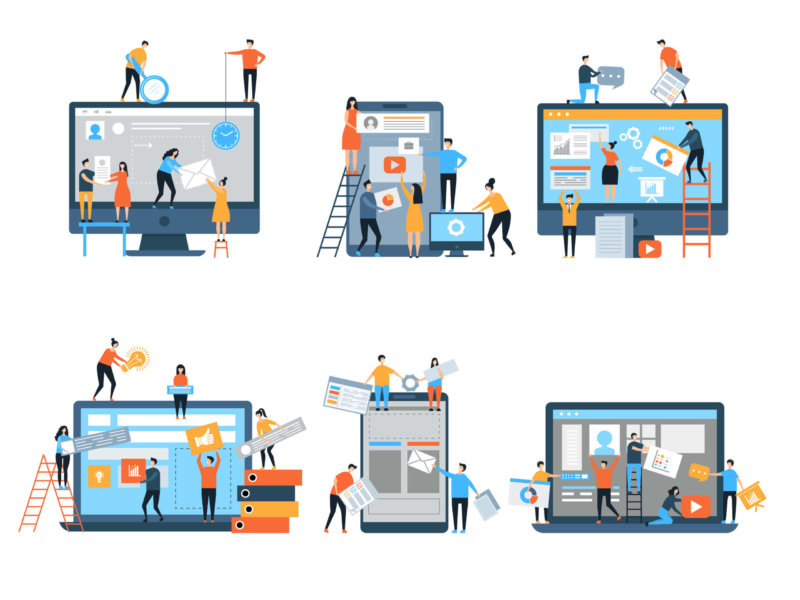B2B Connection
Information and resources for technology buyers
Close to a third (31%) of all internet users rely on virtual private network (VPN) services. If you’re not already among them, you may soon be joining their ranks. VPNs have rapidly increased in popularity among businesses, as many companies transitioned to remote working environments in 2020. They allow employees and clients to gain remote access to the company’s private network. But VPNs are also well-suited for individual or personal use. Many people already use personal VPNs to help do things like: Protect their data when using public wifi Stream or download data that may be restricted in their home country Hide their browsing activity from their internet service provider (ISP) But what exactly are VPNs? They help establish a private and secure connection between a public network and a private network. The VPN acts like a tunnel that connects a user from one network to another. This allows users to send and receive data from the private network. VPNs also hide your internet protocol, or IP address, which makes your internet browsing activity virtually untraceable. Watch this short youtube video for a primer on all things VPN. What are VPN protocols? VPN protocols are specific rules that determine how […]
Ironically, many construction company owners can’t afford to spend the time and money to create a functional budget. Yet despite most construction companies being small businesses with less than 50 employees, there are not very many free construction estimating tools that speak to that reality. The following two tools, STACK Takeoff & Estimating and ESTIMATE, are the leading 100% free full-fledged construction estimating software tools on the market today. Below you’ll also find our recommendations for the most popular paid alternatives that, while not completely free, work well for small construction businesses and are cheaper than enterprise-focused construction outfits. The Best Free Construction Estimating Software Tools on the Market STACK Takeoff & Estimating Estimating and takeoff often go hand in hand, so it’s great to have a piece of software that does both for free. With STACK Takeoff & Estimating, you can get more accurate project estimates by using takeoff tools that help you accurately budget for materials and components needed. It’s important to note that while STACK has a (completely) free offering, it also has Plus, Pro, and Enterprise tiers as well. As you can guess, the Enterprise tier is the most comprehensive for both estimating and takeoff. However, […]
You’ve spent hours crafting smart, strategic, and unbiased survey questions. You’ve launched your survey, collected hundreds of responses, and now sit on a treasure trove of data. It’s easy to spend 20 minutes looking at your survey results, pull out the most noteworthy statistic, and call it a day. But failing to rigorously analyze your survey results undermines your entire research project. This article will not only make a case for why you should do in-depth survey analysis but will give you the tools and methods to do it well. If you’re still in the survey design part of your research project, read more about how to design successful surveys. Why Survey Analysis Is Important No matter how large or small your survey is, you can find hidden gems in the results if you dig deep enough. A cursory glance at your quantitative and qualitative data won’t do your research project justice. Survey analysis can make the difference between an unhelpful statistic and a valuable business insight. For example, a simple net promoter score (NPS) survey can tell you how happy or unhappy your customers are. But segmenting your NPS data by industry, company size, or even job title is […]
Deploying virtual desktop infrastructure (VDI) is a great way to simplify the management of multiple PC users—but it won’t suit every company’s needs perfectly. These five use cases will help you decide whether your business should invest in VDI software.
This cluster of closely related terms frequently causes buyer confusion. However, for buyers looking at the better-known Infrastructure-as-a-Service (IaaS) and Platform-as-a-Service (PaaS) categories, it is worth understanding how all four of these categories are similar, and how they differ. The fundamental differences between these related concepts are best understood in terms of increasing abstraction. Abstraction is a term borrowed from object-oriented programming and, in this context, has to do with how different platforms handle complexity and control. This is a helpful way of thinking about the technology stack from the most fundamental bottom layer, with increasing abstraction and agility, as you move up the stack to the top layer. The price for this increasing agility is a loss of control and configurability. Developers generally prefer to take advantage of higher levels of abstraction. This allows them to focus on application development and avoid distracting (but necessary) overhead work, such as server maintenance and capacity planning. This continuum of increasing abstraction means that PaaS buyers may want to include emerging adjacent technologies like Container-as-a-Service (CaaS) and Functions-as-a-Service (Faas) as part of their consideration set. The following table illustrates how PaaS relates to other adjacent “as-a-Service” platforms, and sheds some light on […]
Tableau is one of the most popular business intelligence solutions on the market, and for good reason. Users can leverage Tableau to create robust and interactive visualizations based on an analysis of big data sources. Tableau visualizations are available on all screen sizes and most devices, making it a powerful and versatile data visualization tool. For some, you may have heard of its capabilities, but are still confused about what exactly the software does. At its heart, business intelligence solutions offer ways to gain insights from vast amounts of data, often in real-time. Though the types of software vary in capabilities, all are based around data analytics and creating actionable insights. Despite these strengths, Tableau can be too pricey for a lot of businesses and requires savvy users to create visualizations that require complex querying. Tableau also lags behind some business intelligence trends when performing tasks besides visualizations, such as large-scale reporting. For these reasons, Tableau isn’t right for every business. Fortunately, there are many business intelligence software alternatives. The alternatives listed below are top-rated business intelligence tools on TrustRadius that are frequently compared to Tableau. Qlik Sense “Qlik Sense offers an end-to-end solution that scales well. I would advise […]
Higher conversion rates can mean higher sales, traffic, and so much more. Check out these tips on how to improve your conversion rates.
If you’re an HR professional coming up on the end of the year, you’re probably begging for an end to end-of-year performance reviews, engagement surveys, or managing employees’ time off for the holidays. If any of those activities made you cringe to just think about, you probably need to invest in talent management software! These products can help turn HR headaches into clear value-adding processes when it comes to make the most of the talent you’re already paying for. Talent management can be a vague, ill-defined area, and knowing what tools you need to manage your talent isn’t always a simple task. We’ve curated a list of 11 questions you should ask yourself to help clarify your requirements for your future talent management software. These questions touch on what your talent pool looks like, what HR software you currently use, and what talent management features you should prioritize. For a quick refresher on what talent management software is, check out the youtube video below: Know your labor pool 1. Will your personnel benefit from talent management? Not all talent management software is equally suited to all talent pools. There are more granular questions we’ll address later on, but the first […]
While there are many reasons to use Skype, there are a plethora of other options out there. Skype for Business has been decommissioned, and the platform as a whole has seen a decrease in popularity. Web conferencing has become a bigger part of business and personal use in the last year. For many, video-based long-distance communication is now essential. A large number of options give you the opportunity to pick a web conferencing software that best fits your needs. Understanding how they compare, both to skype and each other, can help you make this choice. For those looking for a more visual comparison of skype alternatives, check out our video on the Top 5 Skype Alternatives below. Web Conferencing and Skype Alternatives The benefits of web conferencing are well documented. For larger organizations, it can reduce travel time and costs. For smaller ones, it can save vital office resources. It increases the flexibility of working options for organizations of all sizes. It can even expand the pool of available talent you can draw from. Despite these reasons, all web conferencing solutions are not created equal. For business users, Skype has a serious issue. Skype for Business has been completely turned […]
The market for Learning Management Systems (LMS) is overflowing with different products. Ranging from monthly subscriptions to individual downloads, the sheer amount of options is staggering. LMS software provides a central location for instructors to manage and deliver educational materials, including videos, courses, and training documents. LMS software can be used in any training or development environment, from schools to businesses. Many LMS platforms provide performance tracking and analysis. There are two main types of LMS: Corporate LMS and Academic LMS. The first type of LMS used was Academic LMS in K-12 environments and higher education. Academic LMS is for teaching students and providing teachers with professional development. Beyond academia, most LMS in use today are Corporate LMS. Corporate LMS is used internally to train and develop employees and externally to teach customers how to use products. Some companies, such as Brightspace, make both an academic version of their LMS and a corporate version. For those who want a quick refresher of what makes an LMS generally, check out the video below: Corporate LMS Versus Academic LMS Corporate LMS Academic LMS Primary Focus Providing online materials for training and development, specifically in professional settings. Learning software with a focus […]
Marketing Automation Software allows companies to scale beyond what human efforts would allow. Find the best MA software for you here.
If you’re looking to scale up your applicant tracking capabilities on an enterprise-level, you’re likely prioritizing a few key features for your next applicant tracking system (ATS). Robust and customizable resume parsing will be key to helping recruiters automatically filter out as many poor-fit candidates as possible. Functional integrations with the rest of your HR suite will be key to achieving streamlined data flow. And finding a product that supports uncapped candidate pools and user seats will be key to supporting high-volume recruitment while keeping your budget intact. Out of hundreds of ATS products on the market today, not all will provide the features you need on an enterprise scale. Below you’ll find a shortlist of the most popular ATS software to help you sort through the options, as chosen by real enterprise end-users. By learning from their experience, you’ll be able to shorten the research process and secure your next game-changing ATS tool in record time. The 6 Most Popular ATS Software for Enterprise Users We curated the following list of products based on review feedback from enterprise end-users on TrustRadius. This list includes products on the ATS TrustMap with at least 5 ratings or reviews from enterprise users […]
As the second largest search engine, YouTube is a reputable platform that brings in revenue from video content. YouTube SEO tools help businesses improve the quality of video content. They also provide a better understanding of subscribers. Ultimately, YouTube SEO tools make channels more profitable. There are different categories of tools that support YouTube marketers in their SEO efforts. YouTube SEO typically involves research on keywords, trends, and even competitors. You can find a number of free tools to boost your channel’s growth. This piece will give you an overview of the most affordable YouTube SEO tools and link them to important SEO concepts. Essential Tools for YouTube Marketing The best YouTube SEO tools optimize video content and target keywords that are commonly used in search queries. They also strategically improve your video description or video title and use social media to bring more attention to your channel. Each of the tools below are extremely capable of improving your YouTube marketing strategies. With that said, they are useful for different elements of YouTube SEO. You should use the information below to determine which is right for you. YouTube SEO Tool Function Price Biggest Pro Biggest Con Google Keyword Planner Keyword […]
All too often, Human Resource digitization and development feels like an afterthought, with consequences for businesses and employees alike. HR is a foundational aspect of acquiring, retaining, and getting the most value out of your personnel, and HR software plays a crucial role in enabling success. One obstacle to modernizing HR processes can be confusion over what kind of product can best fit your needs. The confusion around different HR software options is understandable since there’s a substantial overlap between what various product types offer. In particular, HRIS and HCM products both fall under HR management software, but are not identical product lines. A Human Resource Information System (HRIS) is the foundational system of record that underlies “core HR” functionalities that all businesses need, while Human Capital Management (HCM) suites provide a broader set of strategic HR functions on top of core HR. While there are still robust HRIS-only options, HCMs have become the most prevalent product. What is an HRIS? At its core, an HRIS is a central repository of employee data, including professional and relevant personal data like addresses and direct deposit data. This data source is used to enable HR functions that every business uses, such as […]
Buying new HR software can be challenging – how do you begin to go about finding the right product that meets all of your business’s needs? Read through this list of the top five HR software challenges that professionals face today based on a survey of HR professionals we conducted. Also, see our suggestions on how to make better-informed purchasing decisions. The Top 5 HR Software Challenges That Users Face If you are an HR professional who has had some difficulty finding the right HR Management software, you are not alone. According to our latest survey, more than 68% of HR software users agree that it’s difficult to find the right software. So which HR software challenges are professionals struggling with the most, and where do you start? Read through the five main challenges that HR software users face today and see our tips on how to resolve them, to find the right product for your organization. You can also check out instructional videos to make sure you are getting the most out of the systems you are paying for. Channels like HR party of One on Youtube can offer fantastic advice. Vendors also usually offer video content to help […]
TrustRadius has 33 HR software categories. There are some people who love reading through them all. For everyone else, there’s mastercard this piece. If you’re looking for a specific type of HR management software, a unique set of software types, or a full suite, we’ve provided a roadmap of different types of “management” software that help HR professionals. This roadmap breaks down each category, including what other categories it’s most similar or interconnected with, and what some of the top products in the category are (with an emphasis on standalone products). HR Management HR Management software is often used as an umbrella term for many different types of software. However, “HR Management” also refers to a specific type of software, also known as “Core HR” or “HR Information Systems.” These products cover three areas central to any HR activities: Benefits administration, personnel tracking, and payroll. Some Core HR products also offer Asset Management and Leave/Attendance Management. There is also a segment of products known as “Human Capital Management suites.” These suites have a Core HR foundation, but also include broader HR capabilities. Almost any type of software discussed in this roadmap could be found in an HR Management suite, but […]
Firewalls are among the most common form of digital security, alongside antivirus software. Since firewalls monitor traffic packets to and from a network and block malicious content, they’re well suited to foiling hackers. Many systems come with a prebuilt firewall. For instance, many wifi routers have basic hardware firewalls. There are also build-in software firewalls in many operating systems, like Windows. Given these measures, some may question how necessary a separate firewall is in their situation. These default protections may be enough for personal use. There are many cases where additional security is recommended, or even required. For instance, any business user should have more robust firewall protections. Determined attackers can often breach default protections. Businesses, and others with sensitive data like financial information, are often their targets. This also includes personal contractors and freelancers, who interact with other businesses’ data. For these users, there is often much more financial and legal risk from malware and intrusion. Separate firewall software dramatically reduces this risk. What Kind of Firewall Do I Need? In some cases, paid firewall products are a necessity. This is most often the case for larger businesses and enterprises. For these organizations, paid firewalls offer more security and […]
America may run on Dunkin’, but the online world runs on APIs. In recent years, APIs have become the de-facto standard for organizations to make their data accessible. APIs are particularly important for accessing data at scale. Many of these APIs require paid access. There are also a multitude of free APIs for publicly available data. For some, the volume of free APIs can be overwhelming. Fortunately, most APIs specialize to deliver a specific kind of data. Some exist only to provide testing data. Others target specific industries or use cases. Not all APIs are created equal, either. Differentiating between APIs is crucial to getting the best data for your use case. Users should first understand what kind of API they need to use. Types of APIs APIs (Application Programming Interfaces) are standardized portals for systems to intake and output data from a database. They are often used to automatically transfer data between systems. They can also be queries manually if users know how to call the API. There are four main types of APIs: Open APIs, Partner APIs, Internal APIs, and Composite APIs. The most relevant type for today is Open APIs. Open APIs are publicly accessible. They are […]
We live in a digital age. Our digital world is filled with millions of talented people working on a diverse set of projects that power our online and offline lives. The people who design what we access on our screens are masters at planning, communicating, collaborating, and ultimately creating. These are the people who make up digital project management, and at the center of digital project management is, naturally, the digital project manager. If you have come across these terms during conversations at work, but aren’t familiar with what this really means, we break them down for you here. What is Digital Project Management? Digital project management is a young practice in modern businesses. Because of this, there are multiple ways to understand it. Some define it as project management with a digital flair. Some don’t think it is project management at all. Others use it interchangeably with IT project management. So what does digital project management really mean? Digital project management is about getting things done in a digital world. Maybe that seems too simplistic. The thing is, digital project management has a simple goal, but can employ multiple complex tools to get the job done. For more visual […]
Enterprises are drowning in data. The sheer volume of data about customers, suppliers, products, and business partners has never been so extensive and yet so crucially important. Data mining is more effective at gathering information at scale, and data warehouses are better at storage. Modern BI tools matter precisely because they promise to make sense of the tsunami of data and uncover the insights within that are vital to winning in the marketplace. The development of BI technology has largely been focused on fulfilling that elusive goal. This article explains the major shifts in approaches to business intelligence and outlines the advantages of the most recent evolution of this technology based on automation through machine learning and AI. As BI vendors move towards this new approach, buyers need to understand this shift as they evaluate products. For more visual learners, check out this video on the history of BI. The First Generation of BI: IT as Central Guardian The first generation of business intelligence software was largely managed by the IT department as the central guardian of all enterprise data. The Extract, Transform, Load (ETL) paradigm combined data from multiple systems to a single database, data store, or warehouse for […]





















